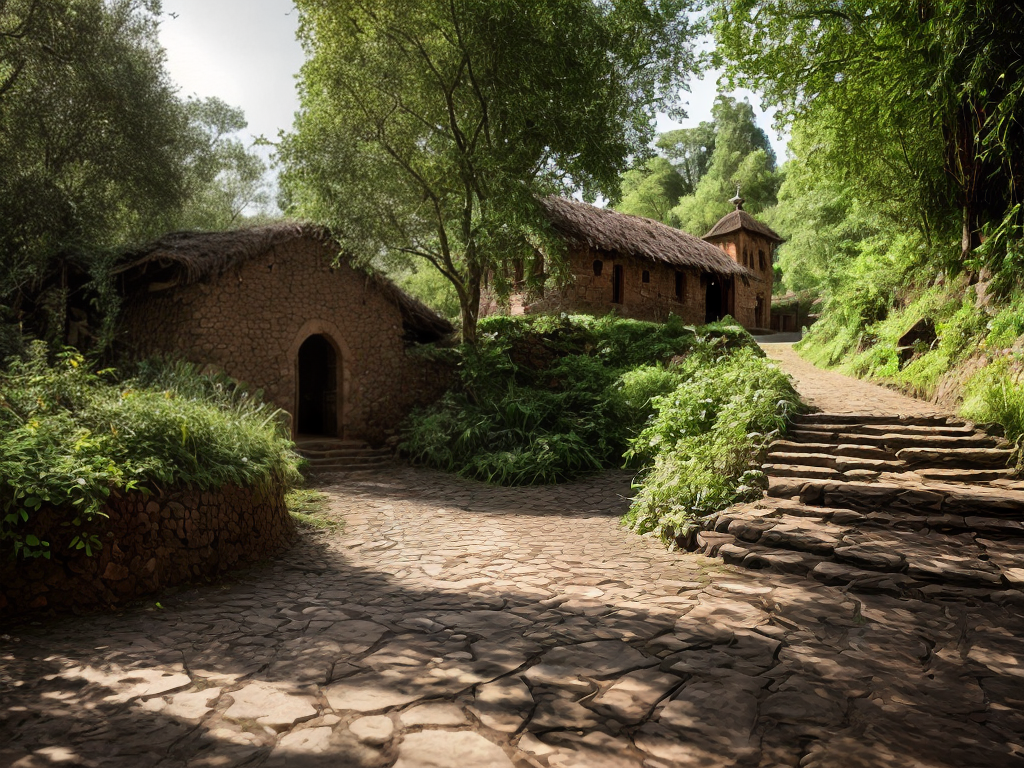As I stood at the entrance of Lalibela, I felt as if I had stepped into a portal that transcended time and space. The air was thick with a sense of ancient mystique, and the earth beneath my feet seemed to whisper stories of a long-forgotten past. The sacred sites of Ethiopia’s Lalibela are a treasure trove of spiritual wonders, waiting to be explored and understood. From the rock-hewn churches that defy architectural norms to the hidden passages and tunnels that hold untold secrets, each corner of Lalibela holds a piece of its divine tapestry. Join me on this journey as we peel back the layers of Lalibela’s spirituality, uncovering its ancient origins, delving into its religious traditions, and uncovering the enduring legacy that continues to captivate the hearts and minds of all who visit.
The Ancient Origins of Lalibela
The ancient origins of Lalibela can be traced back to the 12th century, when a visionary king set out to create a divine city of rock-hewn churches. Lalibela, located in the Amhara region of Ethiopia, is renowned for its unique architectural wonder and historical significance. These rock-hewn churches, carved entirely out of solid volcanic rock, are not only a testament to the creativity and engineering skills of the time but also serve as important religious and pilgrimage sites for Ethiopian Orthodox Christians.
The city of Lalibela was named after King Lalibela, who ruled Ethiopia from 1181 to 1221. According to legend, Lalibela was divinely inspired to build a “New Jerusalem” in Ethiopia, as a response to the capture of Jerusalem by Muslims. This vision led to the construction of eleven monolithic churches, each representing a significant biblical site. The churches were carved from the top down, with the builders meticulously chiseling out intricate details such as windows, doors, and columns.
The rock-hewn churches of Lalibela hold immense religious and historical significance for Ethiopians. They serve as active places of worship, attracting thousands of pilgrims and visitors every year. The churches are adorned with religious paintings, ancient manuscripts, and religious relics, providing a glimpse into the rich spiritual and cultural heritage of Ethiopia.
Lalibela is not only a UNESCO World Heritage site but also a living testament to the ancient Ethiopian civilization and its enduring faith. The intricate architecture, religious symbolism, and historical context make Lalibela a truly remarkable destination for those seeking a deeper understanding of Ethiopia’s ancient origins and religious traditions.
The Legend of King Lalibela
After witnessing the divine inspiration behind the construction of Lalibela’s rock-hewn churches, one cannot help but be captivated by the legend of King Lalibela. Legend has it that Lalibela, the 12th-century Ethiopian king, was divinely chosen to construct the churches as a symbol of Jerusalem’s holy sites. Here are three fascinating aspects of the legend that add to the spiritual significance of pilgrimage to Lalibela:
-
Divine Intervention: According to the legend, King Lalibela was visited by angels in his dreams, who commanded him to build a “New Jerusalem” in Ethiopia. This divine intervention gave him the vision and guidance to create the breathtaking rock-hewn churches that we see today.
-
Miraculous Construction: The legend tells of Lalibela’s miraculous ability to summon celestial beings and supernatural powers to aid in the construction of the churches. It is believed that, with the help of angels, Lalibela and his workers carved the churches out of solid rock in just a few decades, a feat that would have taken centuries for ordinary mortals.
-
Spiritual Journey: The legend of King Lalibela adds a profound layer of spirituality to the pilgrimage experience. It is believed that visiting Lalibela, walking in the footsteps of the divinely inspired king, and praying in the holy churches, can bring blessings, forgiveness, and spiritual enlightenment to pilgrims.
The legend of King Lalibela is a testament to the deep spiritual significance of Lalibela’s rock-hewn churches. It adds a sense of awe and wonder to the pilgrimage experience, making it a truly transformative journey for those who seek a connection with the divine.
The Rock-Hewn Churches of Lalibela
With its remarkable architecture and rich spiritual history, the Rock-Hewn Churches of Lalibela stand as a testament to the ingenuity and devotion of ancient Ethiopian civilization. Exploring the architectural marvels of Lalibela is like stepping into a world frozen in time. These churches, carved out of solid rock, have captivated visitors for centuries with their intricate details and awe-inspiring beauty.
Uncovering the ancient techniques used to construct these churches is a fascinating journey. The builders of Lalibela employed a method known as monolithic architecture, where entire structures were carved out of a single piece of rock. This technique required immense skill and precision, as the artisans had to carefully chip away at the rock to create the desired shapes and designs. It is believed that the churches were built from the top down, with the builders starting at the roof and working their way downwards.
The rock-hewn churches of Lalibela are not only architectural wonders but also hold great spiritual significance. Each church has its own unique design and is dedicated to a different saint or biblical figure. The intricate carvings and frescoes adorning the walls depict scenes from religious stories and serve as a visual representation of the deep faith of the people who built them.
Visiting Lalibela is a truly immersive experience, where you can not only marvel at the architectural marvels but also witness the devotion of the local people. The churches, still actively used for worship, offer a glimpse into the religious practices and traditions that have been passed down through generations. It is a place where you can feel the spiritual energy and connect with a history that is both ancient and timeless.
Exploring the First Group of Churches
Continuing our exploration of Lalibela’s architectural wonders, we now turn our attention to the first group of churches. As I stepped into the sacred complex, I was immediately captivated by the grandeur and mystery that surrounded these ancient structures. Here is what I discovered:
-
Biete Medhane Alem: This church, meaning “House of the Savior of the World,” is the largest monolithic church in Lalibela. Its intricate carvings and impressive size make it a true architectural marvel. As I gazed at its towering walls, I couldn’t help but feel the weight of history and spirituality.
-
Biete Maryam: Nestled in a quiet corner, Biete Maryam is known for its beautifully preserved frescoes that adorn the walls. These vibrant paintings depict scenes from the Bible and Ethiopian religious traditions. It was truly a privilege to witness such ancient relics and immerse myself in their timeless beauty.
-
Biete Golgotha Mikael: As I entered this church, I felt a sense of reverence and awe. Biete Golgotha Mikael is believed to house the tomb of King Lalibela himself. The atmosphere was hushed, and the flickering candlelight added to the sacred ambiance. It was a humbling experience to stand in the presence of such historical significance.
Exploring these architectural marvels and unearthing ancient relics in Lalibela was an unforgettable journey. The craftsmanship, spirituality, and cultural significance that permeate these churches are truly remarkable. I couldn’t help but marvel at the dedication and skill of the artisans who carved these extraordinary structures out of solid rock. Lalibela’s first group of churches is a testament to the rich history and unwavering faith of the Ethiopian people.
Uncovering the Hidden Passages and Tunnels
As I explore the sacred sites of Ethiopia, I am fascinated by the hidden passages and tunnels that lie beneath these ancient structures. These secret underground pathways and labyrinthine tunnels hold a sense of mystery and intrigue, waiting to be unveiled. By uncovering these sacred passages, we can gain a deeper understanding of the history and significance of these sites, shedding light on the spiritual practices of the past.
Secret Underground Pathways
Exploring the fascinating history of Ethiopia’s sacred sites reveals a hidden world of secret underground pathways, uncovering a network of hidden passages and tunnels. These secret underground pathways serve as a testament to the ingenuity of the ancient Ethiopians, providing a glimpse into their architectural prowess and spiritual devotion. Here are three intriguing aspects of these underground passages:
-
Intricate Architecture: The underground passages are meticulously carved out of rock, showcasing exquisite craftsmanship and attention to detail. The intricate designs, including arches and pillars, demonstrate the skill and artistry of the builders.
-
Sacred Purpose: These hidden tunnels were not merely functional structures but held great spiritual significance. They were used by pilgrims to access sacred sites and served as a means of connecting with the divine.
-
Mystery and Intrigue: The secret underground pathways hold an air of mystery, sparking the imagination and inspiring wonder. As you navigate through these hidden tunnels, you can’t help but feel a sense of awe and reverence for the ancient traditions and beliefs that they represent.
The exploration of these secret underground pathways offers a unique and intimate experience, allowing you to connect with Ethiopia’s rich spiritual heritage in a profound and meaningful way.
Hidden Labyrinthine Tunnels
Hidden beneath the surface of Ethiopia’s sacred sites lie a network of labyrinthine tunnels, revealing a captivating world of mystery and intrigue. These hidden passages, known as the underground network, have fascinated explorers and historians for centuries. These ancient tunnels, carved deep into the earth, are believed to have served various purposes, from connecting sacred sites to providing secret escape routes. The intricate maze-like design of these passages adds to their enigmatic allure. Exploring these hidden labyrinthine passages is like embarking on a journey through time, as each tunnel holds a story waiting to be unraveled. The walls are adorned with ancient inscriptions and symbols, hinting at the spiritual significance of these underground pathways. Venturing into these hidden tunnels is an intimate experience, where one can feel the presence of the past and connect with the spirituality of Ethiopia’s sacred sites.
Unveiling the Sacred Passages
The labyrinthine tunnels hidden beneath Ethiopia’s sacred sites have long intrigued explorers and historians, revealing a captivating world of mystery and intrigue. Uncovering these hidden passages not only offers a glimpse into the architectural marvels of the past, but also unveils the spiritual significance of pilgrimage in Ethiopian culture. As I ventured through these underground passageways, I discovered a profound sense of connection to the sacred spaces above ground. Here are three fascinating insights I gained:
-
Ancient Engineering Marvels: These tunnels, meticulously carved out of solid rock, showcase the ingenuity and craftsmanship of the ancient Ethiopian civilization. The precision and complexity of the tunnels leave visitors awe-struck.
-
Spiritual Journey: Navigating through these hidden passages enhances the pilgrimage experience, allowing pilgrims to feel a deeper connection to their faith and the sacred sites they visit. It creates a sense of transcendence and spiritual awakening.
-
Symbolic Significance: The hidden passages symbolize the spiritual journey of the pilgrim, representing the challenges and obstacles one must overcome to reach enlightenment. It is a metaphorical representation of the pilgrim’s inner transformation and the quest for spiritual growth.
Exploring these sacred passages is an invitation to delve into the rich history and profound spirituality of Ethiopia’s sacred sites, offering a truly transformative experience.
Admiring the Magnificent St. George’s Church
Nestled within the ancient city of Lalibela, St. George’s Church stands as a magnificent testament to Ethiopian architectural mastery and religious devotion. This awe-inspiring structure, carved into solid rock, is a symbol of faith and a marvel of human ingenuity. As I explored its intricate carvings and appreciated the cultural significance of St. George’s Church, I couldn’t help but be captivated by its grandeur.
The church, completed in the 13th century, is dedicated to Saint George, the patron saint of Ethiopia. Its exterior is adorned with elaborate bas-reliefs depicting biblical scenes, saints, and angels. These artistic masterpieces, meticulously carved by skilled craftsmen, showcase the rich religious heritage of the region. Each carving tells a story and invites visitors to delve deeper into the spiritual realm.
Inside the church, I was struck by the vastness of the space and the sense of tranquility that enveloped me. The walls, adorned with beautiful frescoes, seemed to come alive with vibrant colors and intricate details. The ceiling, adorned with wooden beams and painted motifs, added to the overall splendor of the place.
St. George’s Church holds immense cultural significance for the Ethiopian Orthodox Church and is a popular pilgrimage site. Every year, on the feast day of Saint George, thousands of worshippers gather here to celebrate and pay homage to the patron saint. This sacred space serves as a place of worship, reflection, and communal gathering, fostering a deep sense of spiritual connection.
As I left St. George’s Church, I couldn’t help but feel a profound sense of reverence and gratitude. The beauty and majesty of this architectural wonder left an indelible mark on my soul. It is truly a testament to the unwavering faith and artistic genius of the Ethiopian people.
Witnessing the Vibrant Religious Festivals
After experiencing the awe-inspiring beauty of St. George’s Church, I eagerly awaited the opportunity to witness the vibrant religious festivals that bring the Ethiopian community together in celebration and devotion.
-
Religious processions: One of the most remarkable aspects of these festivals is the elaborate religious processions that take place. Participants, dressed in traditional clothing, carry ornately decorated crosses and religious relics as they make their way through the streets. The rhythmic beating of drums and the melodic chants of priests create an atmosphere of reverence and spirituality.
-
Cultural significance: These festivals hold immense cultural significance for the Ethiopian people. They serve as a way to honor their religious heritage and strengthen their sense of community. The festivals provide an opportunity for people from different regions and backgrounds to come together, fostering unity and solidarity. It is a time when families and friends gather to celebrate their faith, share meals, and exchange gifts.
-
Vibrant celebrations: The festivals are characterized by vibrant colors, lively music, and energetic dances. Traditional dances such as the Eskista and the Amhara are performed, captivating spectators with their graceful movements and intricate footwork. The air is filled with the aroma of traditional Ethiopian dishes being prepared and the sound of laughter and joy.
Witnessing these vibrant religious festivals was a truly memorable experience. The deep devotion and joy that permeated the atmosphere were contagious, leaving a lasting impression on my heart. The festivals not only celebrate Ethiopia’s rich religious heritage but also showcase the unity and resilience of its people. It is a testament to the power of faith to bring communities together and inspire devotion and celebration.
The Spiritual Significance of Pilgrimage
Pilgrimage holds a profound spiritual significance for individuals seeking a deeper connection with their faith. It is a transformative journey that allows pilgrims to immerse themselves in a sacred experience and strengthen their relationship with the divine. Faith plays a central role in pilgrimage, as it is the driving force behind the desire to embark on such a sacred journey.
The importance of faith in pilgrimage is undeniable. It is faith that compels individuals to leave the comforts of home and embark on a journey that can be physically and emotionally challenging. It is faith that sustains them through the hardships and keeps their spirits elevated. The act of pilgrimage itself is an expression of faith, a testament to the belief in something greater than oneself.
The transformative power of sacred journeys is evident in the stories of pilgrims throughout history. These journeys offer a unique opportunity for self-reflection, introspection, and spiritual growth. As pilgrims navigate the physical challenges of the journey, they also navigate the depths of their own souls, seeking answers, solace, and enlightenment.
To illustrate the transformative power of pilgrimage, let us consider the following table:
| Pilgrimage Destination | Faith | Transformative Experience |
|---|---|---|
| Lalibela, Ethiopia | Christianity | Witnessing the ancient rock-hewn churches and participating in religious ceremonies deepens the pilgrim’s understanding of their faith and strengthens their spiritual connection. |
| Mecca, Saudi Arabia | Islam | The pilgrimage to Mecca, known as Hajj, is considered a transformative experience that cleanses the soul, strengthens faith, and fosters unity among Muslims worldwide. |
| Varanasi, India | Hinduism | Bathing in the holy Ganges River and performing rituals at the sacred ghats of Varanasi is believed to purify the soul, release past sins, and facilitate spiritual growth. |
| Jerusalem, Israel | Judaism, Christianity, Islam | Visiting the Western Wall, the Church of the Holy Sepulchre, and the Dome of the Rock allows pilgrims to connect with their respective religious traditions and deepen their spiritual understanding. |
Pilgrimage is a powerful spiritual practice that allows individuals to transcend the mundane and connect with the sacred. It is a journey of faith, self-discovery, and transformation that has the potential to profoundly impact the lives of those who undertake it.
Discovering Lalibela’s Sacred Art and Artifacts
Lalibela’s sacred art and artifacts offer a glimpse into the rich cultural heritage and spiritual traditions of Ethiopia. Exploring the hidden treasures of Lalibela is an opportunity to delve into the spiritual significance of its ancient relics and artifacts. Here are three remarkable discoveries that showcase the depth of Lalibela’s sacred art:
-
The Rock-Hewn Churches: Lalibela is renowned for its rock-hewn churches, carved entirely out of solid rock. These architectural marvels are not only impressive in their craftsmanship but also hold immense spiritual significance. Each church represents a different biblical scene or saint, and their intricate carvings and frescoes depict religious stories and symbols. The churches are not just places of worship but also living testaments to the devotion and faith of the Ethiopian people.
-
Iconic Crosses and Religious Art: Lalibela is home to a vast collection of religious art, including intricately crafted crosses, manuscripts, and paintings. These artifacts are not only aesthetically stunning but also hold deep symbolism in Ethiopian Orthodox Christianity. The crosses, adorned with intricate patterns and religious motifs, are considered sacred symbols of faith and protection. The religious art found in Lalibela reflects the devotion and spiritual creativity of its people throughout history.
-
Ancient Pilgrim Tokens: As a significant pilgrimage site, Lalibela has attracted countless pilgrims over the centuries. Many of these pilgrims left behind small tokens as offerings and reminders of their spiritual journey. These ancient artifacts, such as small crosses or prayer beads, provide a glimpse into the personal experiences and spiritual devotion of the pilgrims who visited Lalibela.
Exploring Lalibela’s sacred art and artifacts is a truly enriching experience. It allows us to connect with the spiritual traditions and cultural heritage of Ethiopia, while also appreciating the incredible craftsmanship and devotion that went into creating these ancient relics.
The Mysteries of Lalibela’s Underground Churches
Exploring the underground churches of Lalibela unveils a fascinating world of mystery and awe. As I ventured through the dark and narrow underground tunnels, I couldn’t help but feel a sense of anticipation and excitement. These hidden treasures of Lalibela hold secrets that have captivated historians and archaeologists for centuries.
The underground churches of Lalibela are a complex network of interconnected structures carved out of solid rock. They are believed to have been constructed in the 12th century by King Lalibela himself, who wanted to create a new Jerusalem in Ethiopia. The churches are a testament to the architectural genius and spiritual devotion of the people of that time.
Each underground church is unique in its design and construction. Some are simple and unadorned, while others are adorned with intricate carvings and beautiful murals. The most famous of these churches is the Church of St. George, which is carved in the shape of a cross and is considered to be one of the wonders of the world.
As I explored these underground marvels, I couldn’t help but wonder about the purpose behind their construction. Were they intended as places of worship? Or were they meant to be sanctuaries for the faithful during times of persecution? The answers to these questions remain elusive, adding to the allure and mystique of Lalibela’s underground churches.
In addition to their architectural marvels, the underground churches of Lalibela are also said to house hidden treasures. Legend has it that there are secret passageways and hidden chambers within these structures, where precious artifacts and ancient manuscripts are stored. The search for these hidden treasures continues to this day, as archaeologists and historians delve deeper into the mysteries of Lalibela.
Exploring the underground tunnels of Lalibela is truly a journey into the heart of Ethiopia’s rich history and spiritual heritage. It is an experience that leaves one in awe of the ingenuity and devotion of the people who built these magnificent structures. The hidden treasures of Lalibela continue to captivate the imagination and inspire a sense of wonder in all who visit.
Exploring the Monolithic Churches
As I continued my journey through Lalibela’s sacred sites, I couldn’t help but be enthralled by the monolithic churches that stood before me. These architectural marvels, carved out of solid rock in the 12th century, are a testament to the ingenuity and craftsmanship of the Ethiopian people.
-
Bete Medhane Alem: Also known as the Church of the Savior of the World, Bete Medhane Alem is the largest monolithic church in Lalibela. Its sheer size and intricate carvings leave visitors in awe. Stepping inside, I was enveloped by a sense of peace and spirituality.
-
Bete Giyorgis: This church, shaped like a cross and dedicated to Saint George, is perhaps the most iconic of all the monolithic churches in Lalibela. Standing alone, isolated from the rest, it is said to represent the heavenly Jerusalem. As I approached it, the sight of Bete Giyorgis emerging from the ground was truly breathtaking.
-
Bete Maryam: As I ventured deeper into Lalibela’s sacred landscape, I discovered Bete Maryam, the Church of Mary. This monolithic church has a unique cruciform shape and is adorned with beautiful frescoes. It holds great cultural significance for the Ethiopian Orthodox Church and is a place of pilgrimage for believers.
These monolithic churches not only serve as places of worship but also reflect the rich cultural heritage of Ethiopia. They are a testament to the devotion and faith of the Ethiopian people and hold a special place in their hearts. Exploring these architectural marvels was a transformative experience, allowing me to connect with the spiritual essence of Lalibela and its people.
The Divine Architecture of Lalibela
The divine architecture of Lalibela showcases the remarkable fusion of spirituality and craftsmanship. The monolithic churches, carved out of solid rock, are a testament to the incredible skill and devotion of the craftsmen who built them. Each church is a masterpiece of divine craftsmanship, with intricate carvings and beautiful detailing that reflect the religious symbolism of the Ethiopian Orthodox Church.
One of the most famous churches in Lalibela is Bete Giyorgis, also known as the Church of St. George. This church is carved in the shape of a cross, symbolizing Christ’s sacrifice, and is considered one of the finest examples of rock-hewn architecture in the world. Its perfectly symmetrical design and intricate carvings are a testament to the skill of the craftsmen who built it.
Another notable church in Lalibela is Bete Medhane Alem, which is the largest monolithic church in the world. Its roof is adorned with beautifully carved crosses, and its interior is filled with stunning religious murals and ancient manuscripts. This church is a true testament to the religious symbolism and divine craftsmanship of Lalibela.
The churches of Lalibela are not just architectural marvels, but also sacred places of worship and pilgrimage. They are believed to be a physical representation of the heavenly Jerusalem and are considered holy by the Ethiopian Orthodox Church. The spiritual significance of these churches is deeply ingrained in the hearts of the Ethiopian people, and their divine architecture is a reflection of their unwavering faith.
The Religious Traditions and Practices of Lalibela
My experience of the religious traditions and practices in Lalibela was a profound glimpse into the spiritual devotion that permeates every aspect of life in this sacred Ethiopian city. The religious rituals and cultural significance of Lalibela are deeply rooted in the ancient traditions of the Ethiopian Orthodox Church. Here are three key aspects that stood out to me:
-
Pilgrimage: Lalibela is a major pilgrimage site for Ethiopian Orthodox Christians. Every year, thousands of believers travel to Lalibela to participate in religious festivities and seek spiritual blessings. The pilgrimage journey is seen as a crucial part of their faith and is marked by rituals such as fasting, prayer, and the wearing of white garments. The act of pilgrimage in Lalibela signifies a deep commitment to their religious beliefs and a desire to connect with the divine.
-
Rock-hewn Churches: The rock-hewn churches of Lalibela are not only architectural marvels but also hold immense religious significance. These ancient churches, carved out of solid rock, serve as places of worship and pilgrimage. The intricate carvings and underground passages create a sense of awe and reverence, making these churches a focal point of religious rituals and ceremonies. The faithful gather here to attend mass, receive sacraments, and engage in prayer.
-
Religious Festivals: Lalibela is known for its vibrant religious festivals, which are celebrated with great fervor and joy. These festivals bring the community together and provide an opportunity for believers to express their faith through music, dance, and processions. The most notable festival is Timkat, which commemorates the baptism of Jesus in the Jordan River. During this festival, the streets of Lalibela come alive with colorful processions, traditional music, and spirited dancing.
The religious traditions and practices in Lalibela are deeply intertwined with the cultural fabric of the city. They provide a sense of identity, unity, and spiritual nourishment to the people, making Lalibela a truly sacred place of devotion and reverence.
Sacred Sites Beyond Lalibela
During my exploration of Ethiopia’s sacred sites, I discovered that Lalibela was just the beginning of the country’s rich spiritual heritage. Beyond Lalibela, there are numerous other sacred sites that hold immense significance in Ethiopian culture and history. These sites are deeply rooted in the country’s religious traditions and offer a glimpse into Ethiopia’s diverse and ancient heritage.
One such sacred site is Aksum, located in the northern part of the country. Aksum is known for being the ancient capital of the Aksumite Empire and is believed to be the resting place of the Ark of the Covenant. The site is also home to impressive obelisks, ancient tombs, and the ruins of grand palaces, all of which provide a tangible connection to Ethiopia’s past.
Another notable sacred site is the Debre Damo monastery, situated on a cliff in the Tigray region. This monastery, founded in the 6th century, is one of the oldest in Ethiopia and is accessible only by climbing a sheer cliff face. It is a place of solitude and spiritual retreat, where monks continue to live a traditional way of life.
The third sacred site I visited was the Church of St. George in Lalibela. This monolithic church, carved out of solid rock, is considered one of the wonders of the world. Its intricate architecture and religious significance make it a must-visit destination for those seeking a deeper understanding of Ethiopian heritage.
Through my journey to these sacred sites, I gained a profound appreciation for the spiritual richness of Ethiopia’s heritage. Each site offers a unique and captivating experience, allowing visitors to connect with the country’s ancient traditions and explore the depths of their own spirituality. Ethiopia truly is a treasure trove of sacred sites, waiting to be discovered and cherished.
The Enduring Legacy of Lalibela’s Spirituality
Lalibela’s spirituality continues to leave a lasting impact, transcending time and captivating all who seek a profound spiritual experience. The enduring spirituality of Lalibela is deeply rooted in its cultural significance, and its legacy can be seen in various aspects of Ethiopian culture. Here are three key elements that highlight the enduring spirituality and cultural significance of Lalibela:
-
Architectural Marvels: The rock-hewn churches of Lalibela are a testament to the extraordinary craftsmanship and devotion of the people who built them. These magnificent structures, carved out of solid rock, are not only awe-inspiring in their beauty but also serve as a sacred space where worshippers can connect with the divine. The intricate carvings and underground passageways enhance the spiritual experience, inviting visitors to explore the depths of their faith.
-
Pilgrimage Destination: Lalibela has long been a pilgrimage site for Ethiopian Orthodox Christians, who come from far and wide to experience the spiritual energy that permeates the town. The annual celebration of Timkat, the Ethiopian Epiphany, attracts thousands of pilgrims who gather to commemorate the baptism of Jesus in the Jordan River. This pilgrimage tradition not only strengthens the faith of the believers but also fosters a sense of community and unity among the participants.
-
Living Heritage: The spirituality of Lalibela is not confined to the ancient structures alone; it is alive in the rituals, traditions, and daily life of the people. The priests and monks who maintain the churches play a vital role in preserving the spiritual heritage of Lalibela. Through their prayers, ceremonies, and teachings, they ensure that the enduring spirituality of Lalibela continues to inspire and guide generations to come.







